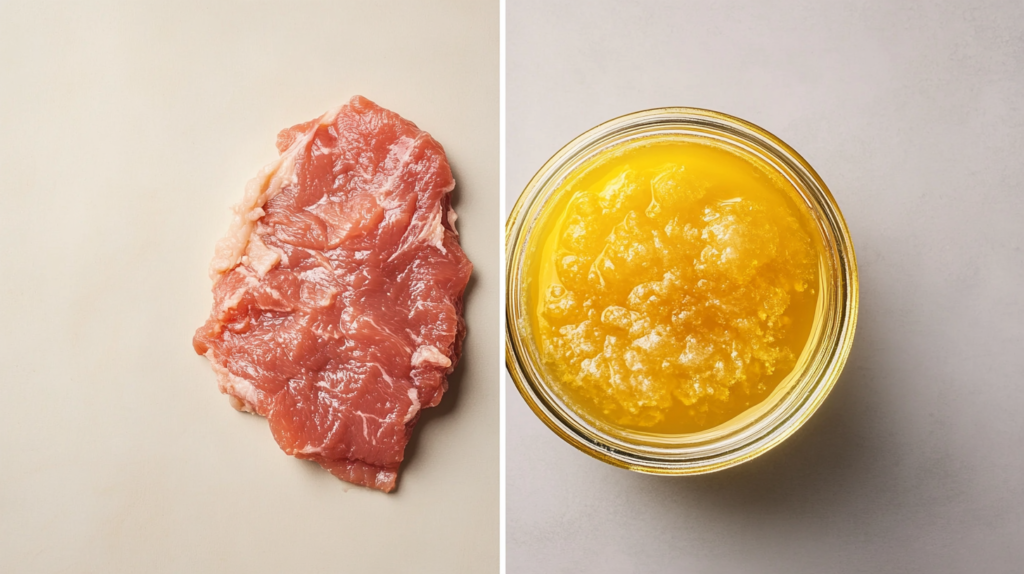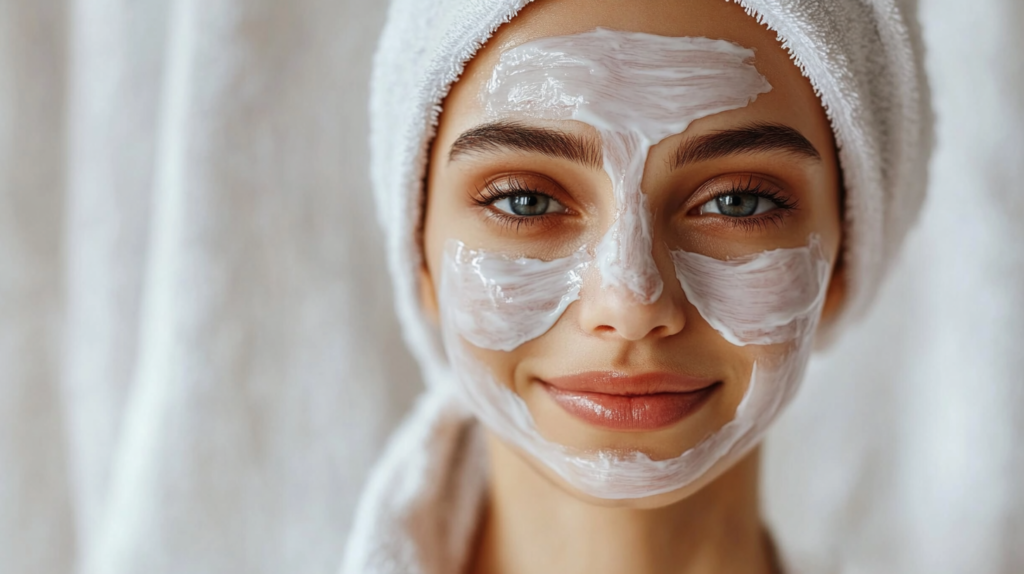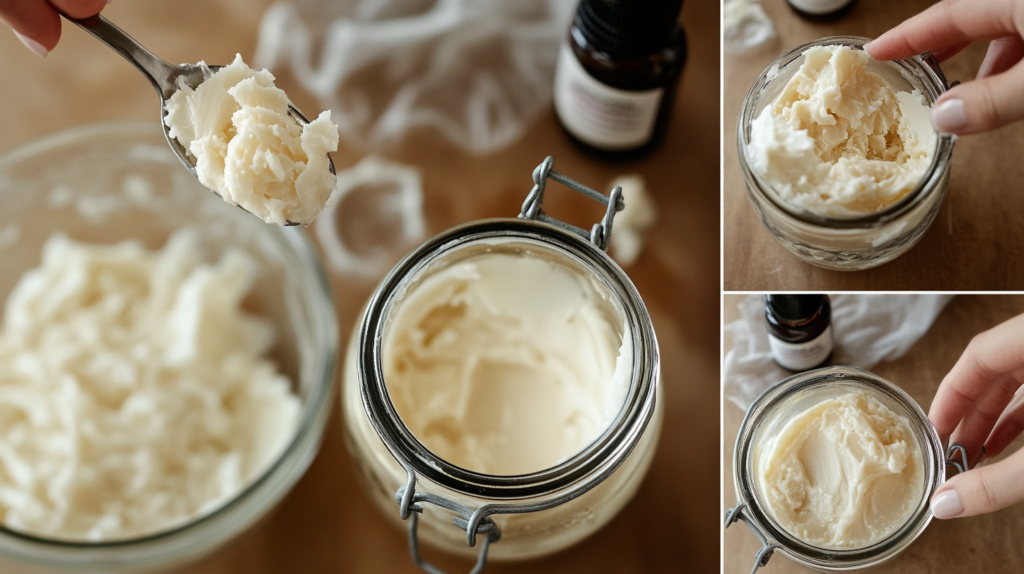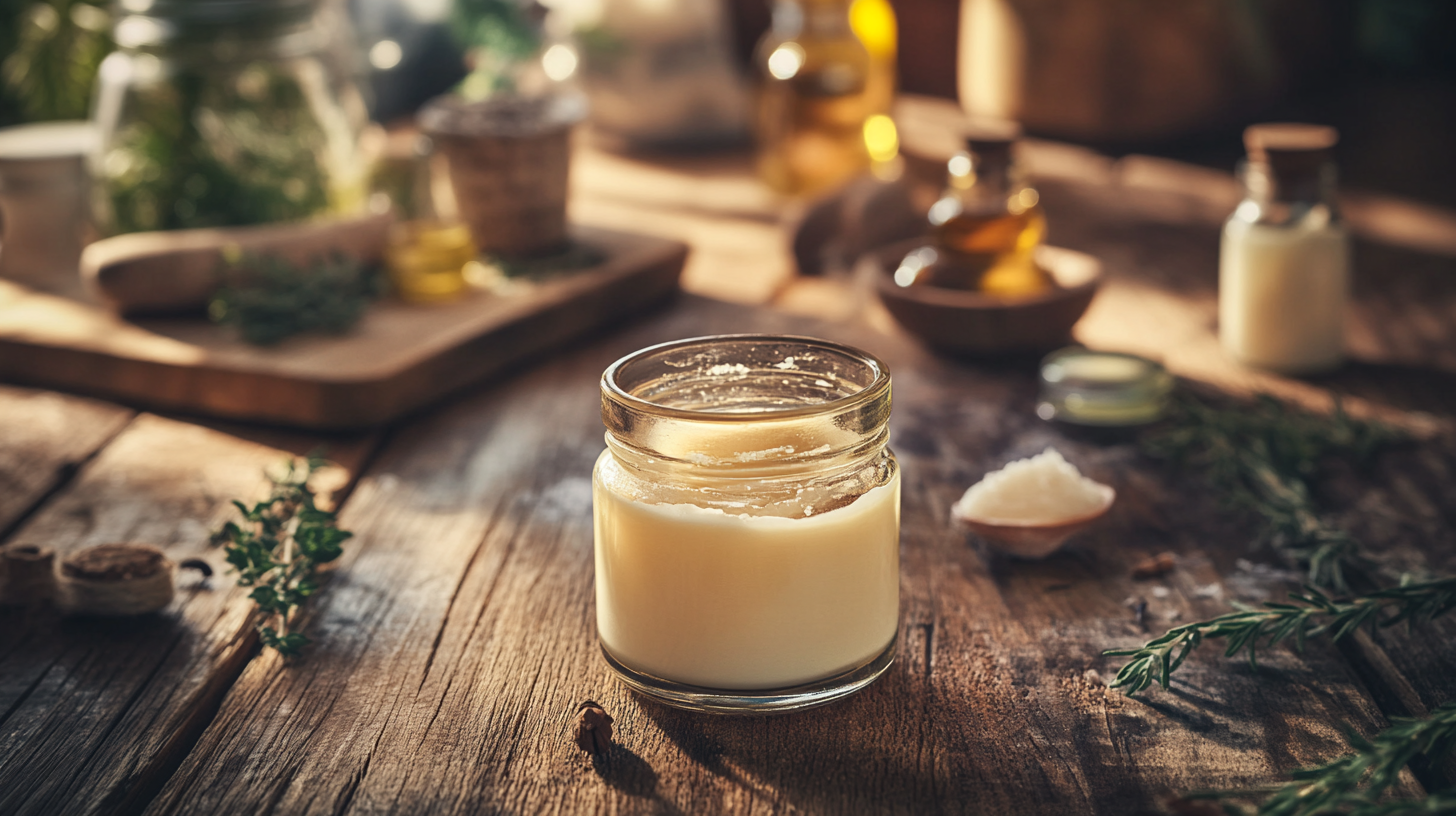Beef tallow has been used for centuries as a natural skincare remedy, offering deep hydration and nourishment for the skin. With the rise of chemical-free and organic skincare, tallow is making a comeback due to its rich composition of essential fatty acids and fat-soluble vitamins.
Unlike commercial moisturizers filled with synthetic ingredients, a homemade beef tallow moisturizer is pure, highly effective, and easy to make. This article explores everything you need to know about using beef tallow for skincare, its benefits, and how to make a simple yet effective tallow moisturizer at home.
Table of Contents
What is Beef Tallow?

Beef tallow is rendered fat from cattle, typically obtained from suet (the fat surrounding the kidneys and loins). When melted and purified, it becomes a stable, nutrient-rich fat that has been traditionally used in cooking, candle-making, and skincare.
Tallow is composed of saturated and monounsaturated fats, making it an excellent natural emollient that locks in moisture and promotes skin health. Since it closely resembles the lipids in human skin, it absorbs well without leaving a greasy residue.
Beef tallow, derived from rendered fat, has long been used in both skincare and cooking. If you’re interested in enhancing beef flavor in different ways, check out The Ultimate Guide to Beef Brisket Brine to learn how brining adds depth to your meat.
Benefits of Beef Tallow for Skin

Beef tallow is packed with skin-loving nutrients that make it an exceptional natural moisturizer.
Rich in Essential Vitamins
- Vitamin A: Supports cell regeneration and skin repair.
- Vitamin D: Helps with skin barrier function and reduces inflammation.
- Vitamin E: A powerful antioxidant that protects against free radicals.
- Vitamin K: Aids in healing scars, stretch marks, and bruises.
Deeply Moisturizing
Tallow is highly effective at restoring dry, cracked, and sensitive skin. It penetrates deeply into the skin layers, providing long-lasting hydration without clogging pores.
Supports Skin Barrier Function
The fatty acid composition of beef tallow is similar to the oils naturally produced by human skin, making it ideal for reinforcing the skin’s protective barrier. This helps prevent moisture loss and protects against environmental damage.
Non-Comedogenic and Suitable for All Skin Types
Despite being an animal fat, beef tallow does not clog pores. It is suitable for all skin types, including oily and acne-prone skin, as it balances oil production rather than overwhelming the skin with excess grease.
Beef Tallow vs. Other Natural Moisturizers
Many natural oils and butters are popular in skincare, but beef tallow stands out due to its unique composition and benefits. Below is a comparison of tallow with other common natural moisturizers.
Beef Tallow vs. Shea Butter
- Beef Tallow: Closely mimics human sebum, deeply penetrating and nourishing the skin.
- Shea Butter: Rich in vitamins and fatty acids, but has a heavier texture and may feel greasy.
Beef Tallow vs. Coconut Oil
- Beef Tallow: Non-comedogenic and balances oil production, making it suitable for acne-prone skin.
- Coconut Oil: Antibacterial but has a high comedogenic rating, which can clog pores for some individuals.
Beef Tallow vs. Commercial Moisturizers
- Beef Tallow: 100% natural with no preservatives, artificial fragrances, or chemicals.
- Commercial Moisturizers: Often contain synthetic ingredients, parabens, and fillers that may irritate sensitive skin.
Tallow has been valued not only for skincare but also for cooking rich, flavorful dishes. If you’re a fan of barbecue, you’ll love this Irresistible Beef Back Ribs Recipe for tender, fall-off-the-bone meat.
Choosing the Best Beef Tallow for Skincare
Not all tallow is created equal. The quality of beef tallow depends on the source and rendering process.
Grass-Fed vs. Grain-Fed Tallow
- Grass-Fed Tallow: Contains higher levels of essential nutrients, including Omega-3 fatty acids and antioxidants.
- Grain-Fed Tallow: May contain lower nutrient content due to differences in diet.
Rendering Tallow at Home vs. Buying Pre-Made
- Homemade Tallow: Allows complete control over purity and quality but requires time and effort.
- Pre-Made Tallow: Convenient but ensure it is from a reputable source, preferably labeled as “skincare grade” or “cosmetic-grade.”
Just as high-quality grass-fed beef produces the best tallow for skincare, it also makes for incredible smoked meats. Try this Green Egg Beef Brisket Recipe for a mouthwatering barbecue experience.
Beef Tallow Moisturizer Recipe (Step-by-Step Guide)

Making your own beef tallow moisturizer at home is simple and allows customization based on your skin’s needs.
Ingredients Needed
- 1 cup of grass-fed beef tallow (rendered and purified)
- 2 tablespoons of extra virgin olive oil (or jojoba oil for a lighter feel)
- 1 tablespoon of raw honey (optional, for added hydration)
- 10-15 drops of essential oil (lavender, tea tree, frankincense, or your choice)
Some variations of beef tallow moisturizer include adding a small amount of beef broth for extra nourishment. If you want more ways to use beef broth in cooking, check out these Delicious Recipes Using Beef Broth.
Step-by-Step Instructions
- Melt the Tallow
- Place the beef tallow in a heat-safe bowl or double boiler. Heat gently over low heat until fully melted.
- Add Oils and Honey
- Remove from heat and stir in olive oil (or jojoba oil) and honey. Mix well to combine all ingredients.
- Cool and Blend
- Let the mixture cool slightly. If you prefer a whipped texture, use a hand mixer to blend until fluffy.
- Add Essential Oils
- Once cooled but still soft, add essential oils and mix thoroughly.
- Store Properly
- Transfer to a clean glass jar with a tight lid. Store at room temperature or in the refrigerator for a firmer consistency.
Essential Oils & Additives for Customization
Customizing your beef tallow moisturizer allows you to tailor it to specific skin concerns. Adding essential oils and natural ingredients enhances its benefits.
Best Essential Oils for Skincare
- Lavender Oil – Soothing, anti-inflammatory, and calming for sensitive skin.
- Tea Tree Oil – Antibacterial and great for acne-prone skin.
- Frankincense Oil – Promotes skin regeneration and reduces signs of aging.
- Chamomile Oil – Reduces redness and irritation, perfect for eczema or rosacea.
Optional Additives for Extra Benefits
- Beeswax – Helps create a firmer consistency and locks in moisture.
- Aloe Vera Gel – Adds hydration and is excellent for sunburned or irritated skin.
- Vitamin E Oil – Extends shelf life and provides additional antioxidant protection.
How to Use Beef Tallow Moisturizer Effectively

Daily Application Tips
- Use a pea-sized amount and massage it into damp skin for better absorption.
- A little goes a long way—tallow spreads easily and provides long-lasting moisture.
- Apply morning and night for best results, especially on dry or problem areas.
Best Uses for Specific Skin Concerns
- For Face Moisturizing – Apply sparingly after cleansing to avoid a heavy feel.
- For Dry or Cracked Skin – Apply generously to elbows, knees, and hands.
- For Eczema or Psoriasis – Mix with chamomile or tea tree oil for soothing effects.
- For Anti-Aging – Use as a night cream to promote skin elasticity and hydration.
Common Myths & Concerns About Using Tallow on Skin
Does Beef Tallow Clog Pores?
No, beef tallow has a low comedogenic rating and absorbs well into the skin, making it suitable for all skin types.
Does Tallow Smell Bad?
Properly rendered and purified beef tallow has little to no scent. Adding essential oils can improve fragrance.
Is Tallow Moisturizer Greasy?
Tallow melts at body temperature but absorbs quickly without leaving a greasy residue.
Is Tallow Safe for Acne-Prone Skin?
Yes, it balances natural oils and has anti-inflammatory properties that help reduce breakouts.
Storing and Shelf Life of Tallow Moisturizer
- Store in a cool, dry place in a tightly sealed jar.
- Refrigeration extends shelf life but is not necessary.
- Properly stored tallow moisturizer can last 6 to 12 months without preservatives.
How to Store and Extend the Shelf Life of Beef Tallow Moisturizer
Proper storage is essential to maintain the freshness and effectiveness of your homemade beef tallow moisturizer. Since tallow is a stable fat, it has a naturally long shelf life, but certain precautions can further extend its usability.
Best Storage Methods
- Glass Jars: Always store tallow moisturizer in an airtight glass jar. Avoid plastic containers, as they can leach chemicals into the product over time.
- Cool, Dark Place: Keep the jar in a cool, dry place, away from direct sunlight. A bathroom cabinet or pantry works well.
- Refrigeration (Optional): While not necessary, storing tallow moisturizer in the fridge can extend its shelf life and keep it extra firm.
Shelf Life of Beef Tallow Moisturizer
- Room Temperature: Lasts 6 to 12 months when stored properly.
- Refrigerated: Can last up to 2 years without any preservatives.
- Signs of Spoilage: If your tallow moisturizer develops a rancid smell, changes color, or has mold growth (very rare), it’s time to discard it.
How to Make Whipped Beef Tallow Moisturizer for a Softer Texture
For those who prefer a lighter, fluffier texture, whipping beef tallow after it cools slightly can create a smooth, airy consistency that is easier to apply.
Steps for Whipping Tallow Moisturizer
- Melt the tallow and mix in any carrier oils (olive, jojoba, etc.).
- Let it cool at room temperature until it starts to solidify but is still soft.
- Use a hand mixer or stand mixer to whip the tallow for 3-5 minutes until it becomes light and fluffy.
- Store in a jar and keep in a cool place to maintain the texture.
Whipped tallow moisturizer spreads easily and absorbs faster, making it a great option for facial use or lightweight body application.
Best Carrier Oils to Mix with Beef Tallow for Different Skin Types
Beef tallow works well on its own, but adding specific carrier oils can further enhance its benefits based on your skin type.
| Skin Type | Best Carrier Oils to Use | Why It Works |
|---|---|---|
| Dry Skin | Avocado Oil, Olive Oil | Deeply moisturizing and rich in vitamins |
| Oily Skin | Jojoba Oil, Grapeseed Oil | Lightweight and helps balance oil production |
| Sensitive Skin | Sweet Almond Oil, Chamomile Oil | Soothing and anti-inflammatory |
| Aging Skin | Rosehip Oil, Argan Oil | High in antioxidants and supports collagen production |
Customizing your tallow moisturizer with these oils allows you to create a product that best suits your skin’s needs.
FAQs About Beef Tallow Moisturizer
1. Can I use beef tallow on my face daily?
Yes, beef tallow is gentle enough for daily use. Apply a small amount to clean, damp skin for best absorption.
2. Does beef tallow help with wrinkles?
Yes, tallow contains vitamins A, D, E, and K, which support collagen production and skin elasticity, reducing fine lines and wrinkles.
3. Can I mix beef tallow with other butters like shea or cocoa butter?
Absolutely. Mixing tallow with shea or cocoa butter can enhance its texture and add extra moisturizing properties.
4. Is beef tallow safe for babies?
Yes, tallow is a natural and non-toxic moisturizer that is safe for babies. It is often used for diaper rash and dry skin.
5. Can I use beef tallow moisturizer on my scalp and hair?
Yes, tallow can be used as a scalp treatment for dryness and dandruff. Apply a small amount and massage it into the scalp before washing.
6. Will my skin smell like beef if I use tallow?
No, properly rendered tallow has little to no odor. Adding essential oils can further enhance its scent.
7. How to Make Skin Moisturizer with Beef Tallow?
Making a skin moisturizer with beef tallow is simple and requires only a few natural ingredients.
Ingredients:
- 1 cup grass-fed beef tallow (rendered and purified)
- 2 tablespoons olive oil, jojoba oil, or sweet almond oil (for a softer consistency)
- 1 tablespoon raw honey (optional, for extra hydration)
- 10-15 drops essential oil (lavender, tea tree, or frankincense for added benefits)
Instructions:
- Melt the Tallow – Use a double boiler or heat-safe bowl over simmering water to gently melt the tallow.
- Add Oils and Honey – Stir in the olive or jojoba oil and honey until fully combined.
- Let Cool and Whip (Optional) – Allow the mixture to cool slightly, then whip with a hand mixer for a fluffy texture.
- Add Essential Oils – Mix in essential oils for fragrance and extra skin benefits.
- Store in a Jar – Transfer the moisturizer to a glass jar and keep it in a cool, dark place.
This homemade beef tallow moisturizer provides deep hydration, skin protection, and nourishment with all-natural ingredients.
8. Can You Use Beef Tallow as a Moisturizer?
Yes, beef tallow is an excellent natural moisturizer. It is rich in essential fatty acids and fat-soluble vitamins (A, D, E, and K), which deeply hydrate and nourish the skin. Because tallow closely resembles human sebum, it absorbs well without clogging pores, making it suitable for most skin types, including dry and sensitive skin.
Tallow moisturizer can be applied to the face, body, and problem areas like cracked heels, eczema patches, and dry elbows. A small amount goes a long way, and it is best applied to damp skin for maximum absorption.
9. What Are the Disadvantages of Tallow for Skin?
While beef tallow is highly beneficial, there are a few potential downsides to consider:
- Animal-Based Ingredient – Tallow comes from beef fat, making it unsuitable for vegans or those who prefer plant-based skincare.
- Texture and Feel – Some people may find tallow to be too thick or heavy, especially for facial use.
- Mild Natural Scent – If not properly rendered, tallow can have a mild beef-like smell, though this can be masked with essential oils.
- Potential Allergies – While rare, some individuals may have sensitivities to animal fats or proteins.
- Melting in Warm Temperatures – Tallow can soften or liquefy in high heat, so it should be stored in a cool place.
Despite these minor drawbacks, tallow remains a highly effective and natural alternative to commercial moisturizers.
10. Can You Mix Olive Oil and Beef Tallow?
Yes, olive oil and beef tallow can be mixed to create a softer, more spreadable moisturizer. Olive oil adds extra hydration, antioxidants, and a smoother texture.
How to Mix Olive Oil with Tallow
- Ratio – Use about 1-2 tablespoons of olive oil per 1 cup of tallow.
- Method – Melt the tallow, stir in the olive oil, and allow it to cool. Whipping the mixture creates a lighter, creamier texture.
- Benefits – Olive oil enhances moisture retention, soothes dry skin, and provides additional nutrients like vitamin E.
This combination is perfect for those who find pure tallow too thick or heavy and want a more versatile, easy-to-apply moisturizer.
Conclusion
Beef tallow moisturizer is a powerful, natural alternative to commercial skincare products. Rich in essential nutrients, it deeply hydrates, protects, and repairs the skin without harmful chemicals. Whether you’re looking for a simple moisturizer, an anti-aging remedy, or relief for dry and irritated skin, tallow is a versatile and effective solution.
By making your own tallow moisturizer at home, you can customize it to suit your skincare needs while ensuring the highest quality ingredients. Give it a try and experience the benefits of this traditional yet highly effective skincare remedy.

